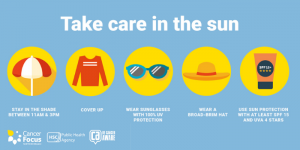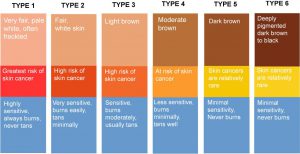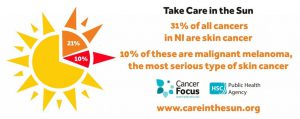
Ultraviolet (UV) rays from The sun can have a damaging effect on our skin and health, whether we are at home or on holiday
Skin cancer is the most common form of cancer in Northern Ireland, accounting for more than 31 percent of all cancers here
Staying safe in the sun
Adults and children need to stay safe in the sun all year round. However, it is particularly important during the summer months (March to October) between 11am and 3pm each day. Often we don’t realise when our skin is being damaged, so it is important to be UV aware. The UV index is a much more accurate way of determining your risk of skin and eye damage than just relying on the air temperature. UV levels can be high enough to damage your skin even on cool or overcast days. When the UV index is 3 or more, we need to protect our skin and eyes. Find out more including how to check the UV index at Care in the Sun | How to Be UV Aware
You can take a number of simple steps to help protect against the sun’s harmful rays:
- Stay in the shade where possible
- Cover up when you are out in the sun
- Wear sunglasses with 100 percent ultraviolet (UV) protection
- Wear a broad brimmed hat
- Use sunscreen with a sun protection factor (SPF) of at least 15 and long wave ultraviolet A (UVA) protection of four stars
The British Association of Dermatologists recommends sunscreen with an SPF of at least 30 (SPF 50 for children or people with pale skin) - Apply sunscreen 30 minutes before going out in the sun and apply again every two hours
If you are confused about what SPF to use for your skin type, try this sun protection factor calculator

-
Sunburn
If your skin has gone pink or red in the sun, it has been burned. Sunburn does not have to be raw, peeling or blistering.
Sunburn is an outward sign of UV damage to the skin and can lead to skin cancers.
You do not have to be sunbathing to get sunburned. Most cases of sunburn happen when people are doing an activity such as:
- gardening
- outdoor sports
- working outdoors
- walking
- cycling
Follow these tips on how to enjoy the sun safely
-
Skin Cancer Risk Factors
There are many factors that increase the risk of skin cancer
Care in the Sun | Risk Factors – Care in the SunMelanoma risk factors
- Lots of moles (50 or more) or unusual moles (large, different colour or irregular border).
- Melanoma rates are higher in older people, although 10 percent of cases are in people aged under 35. There are more than 100 cases diagnosed in Northern Ireland each year in people aged over 70.
- A personal or family history of melanoma skin cancer.
- Dark skinned people can still develop melanoma, usually on the soles of their feet or palms of their hands.
Non-melanoma risk factors
- Chemical exposure, including creosote, tar, soot and petroleum extracts.
- Previous skin damage, for example severe burns to the skin or a history of ulcers.
- Radiation, including radiation exposure as part of cancer treatment.
- Solar keratosis or sun spots.
- A personal or family history of skin cancer.
- History of severe sunburn, especially in childhood.
- Reduced immunity, for example due to an organ transplant.
- Pale skin – the paler your skin, the greater the risk.
- Men are at greater risk than women.
- The risk increases when you are aged over 50.
- Albinism increases the risk.
-
Detecting Skin Cancer
Early detection of skin cancer is very important so you should check your skin about once a month. You should get someone to help check your back and other difficult to see areas..
Get to know your skin and look out for any changes. If you notice any moles or patches of normal skin that are changing in any way size and colour, check it out with your GP.
The ABCD rule can help you check your moles:
- Asymmetry – the two halves of a melanoma may not look the same.
- Border – the edges of a melanoma are often jagged or irregular.
- Colour – a melanoma may be several different shades at once.
- Diameter – this is usually at least six millimetres.
-
UVA and UVB
SPF (UVB)
SPF stands for ‘sun protection factor’ – the sunscreen’s ability to filter out ultraviolet B radiation (UVB).
The higher the SPF number, the greater the protection. SPF 15 will block 93% of UV radiation, while a SPF 30+ will give you more protection, screening out 96% of UV radiation. Find out which SPF you should use.
UVA
UVA protection in sunscreen guards against skin ageing by filtering out ultraviolet A radiation (UVA).

In NI we measure UVA protection with the ‘star’ system. Sunscreens can have anywhere from 0 to 5 stars. Look for a star rating of 4 or more.
Sunscreens manufactured in accordance with the EU recommendation for UVA protection, will be labelled with a UVA logo, the letters ‘UVA’ printed in a circle
Which sunscreen should I buy?
For a good level of protection, choose a broad-spectrum sunscreen that filters out both UVA and UVB radiation and has:
- SPF of at least 15
- UVA star rating of 4 or more
Price or branding are not automatic indicators of the quality of a sunscreen – the critical factor is that the sunscreen you purchase has an SPF of 15 or more and a UVA star rating of 4 or more.
For more information, please click here
-
Summer Skin Care Awareness by Karen Hayes Skin Cancer Nurse

Most Common Sun cream Myths
As the days get longer, the good weather of spring and summer is beginning to peak around the corner and we’ll all be outdoors more with friends and family in no time.
Cancer Focus Northern Ireland, alongside the Public Health Agency, as part of Sun Awareness Week (1 May – 7 May), are encouraging people to stay safe in the sun and be UV aware. With this in mind, they want to highlight some of the most common myths around sunscreen and tanning to ensure you can be better informed to take all the action required to protect your skin from damage.
Even here in Northern Ireland, it’s crucial that we keep ourselves protected from the sun at all times.
Myth 1: We don’t need to use sunscreen in Northern Ireland.
Many people think if the sun is not splitting the trees, sun protection isn’t required! This is not true. Even on cool or cloudy days in Northern Ireland we need to protect our skin against UV rays as these still filter through the clouds.
Myth 2: You only need to worry about skin damage if you get severe sunburn.
This is false. UV damage can start before your skin tans or burns. The UV index tells us how much UV radiation is reaching us from the sun and when the index is at 3 or more, we need to protect our skin and eyes.
Myth 3: The sun in Northern Ireland is not strong enough to damage your skin.
This is not true. Skin cancer is the most common cancer in Northern Ireland and 4 out of 5 cases are due to overexposure to UV rays. Between March and October, UV rays from the sun can be strong enough to damage your skin even when it is cool or cloudy.
Myth 4: My skin doesn’t burn so I don’t need to worry about sun safety.
All skin needs protection. Anyone can develop skin cancer, whatever their skin type. If you work outside or spend a lot of time outdoors, you might think your skin is tougher and doesn’t need protection, but UV damage can still occur.
Myth 5: Having tanned skin looks healthy.
Having tanned skin shows that your skin has been damaged in the short term. The longer-term effects of UV damage, whether or not you get sunburn, can be premature ageing of the skin, deeper wrinkles, uneven skin pigmentation, age spots, sun spots and an increased risk of skin cancer.
Myth 6: Sunbeds are a good way to get a base tan this summer.
A tan from a sunbed or from the sun is a sign that the skin has been damaged by UV rays and is not a sign of good health. Tanning without a sunburn can still cause premature skin ageing and increase the risk of skin cancer through irreparable DNA damage. Each time skin is exposed to UV rays from the sun or from a sunbed, the risk of developing skin cancer is increased.
Myth 7: Sunscreen is water resistant and should be applied only once a day.
Despite what the packaging states, sunscreen should be applied every two hours, or more frequently if sweating, towelling, or in water. At least six full teaspoonful’s of sunscreen lotion are needed for an all over body application for an average adult.
Before going out into the sun, remember:
- Choose a sunscreen with an SPF 15 or more to protect against UVB, and 4 or 5 stars to protect against UVA.
- Ensure you apply plenty of sunscreen 30 minutes before going outside and reapply every two hours after that and straight after swimming, sweating or towel drying.
- Protect your skin with clothing, like a long-sleeved top to protect your arms, and don’t forget to wear a hat that protects your face, neck, and ears.
- Wear 100% UV protection sunglasses to protect your eyes and make sure you spend time in the shade between 11am and 3pm when the UV rays are at their strongest.
- Always keep babies and young children out of direct sunlight.
- Don’t forget to protect the most common missed spots of sun cream which are eyelids, back of knees, ears, tops of feet, sides of face, hands, scalp, and lips.
It is never too late to start protecting your skin in the sun. Now is the time before the good weather kicks in to get a good routine in place to keep your skin looking good.
For more information regarding looking after your skin in the sun visit www.careinthesun.org.



